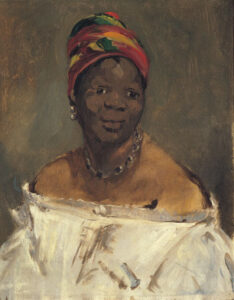by Josephine Gardiner in Cornwall

The reason why Manet’s painting of Victorine Meurent in Olympia outraged the gallery-going public of 1865 was that it appeared to show a prostitute: the artist included many items which, apparently, were associated with prostitution in mid 19th-century Paris, though their significance would be lost on the modern viewer. Worse, this prostitute showed no sign of being ashamed of her profession; she stares – impassive, commanding, contemptuous – directly at her spectators, daring them to comment. Today though, many people might feel more disturbed by what is obscured and ignored in Olympia than by what is included.
Since 1865 and until very recently, discussion of this powerful painting has focused entirely on how Manet subverts convention on painting nude women. Art critics have pointed out that naked Olympia does not seduce or flirt, her eyes are not downcast, she shows none of the soft, sly submission of her many predecessors. Her big, broad hand is clamped over her sex like a padlock. Victorine/Olympia’s indifference to the male gaze has made her something of an early feminist icon.
But mainly it’s all been about Olympia, the white woman on the couch.
There are of course two women in the picture. The one on the right, the maid standing to offer the flowers, was named Laure. Nobody seems to remember her surname. Laure’s voluminous pale clothes emphasise her darkness, and in general there is so much white in the painting – sheets, pillows, Victorine’s paper-white body, Victorine’s white slippers, the white wrapping around the pale flowers – that Laure’s face is almost lost against the dark-green curtains. You need to see a very good reproduction to identify her features at all; in many, her face appears merely as a black absence. She is background. Her presence serves only to enhance the painting’s (admittedly superb) composition, with her physical appearance operating as a negative counterweight to the white subject.
Laure appears again as a nursemaid in Children in the Tuileries Garden. Here her face is entirely obscure (at least in reproduction), but so are most of the others in the work. Manet does attempt to capture Laure’s individual humanity in one portrait (1863), though he titles it La Negresse, rather than, say, ‘Laure’, or even ‘woman in a turban’.
While it seems pointless to speculate about Manet’s own attitudes and intentions 150 years ago, the importance of recognising and reassessing the use of BAME models in art history seems obvious, and this, albeit belatedly, is happening. Last year, an ambitious exhibition at the Musee d’Orsay in Paris (‘Black Models: from Gericault to Matisse’) invited visitors to look again at some of the most famous masterpieces of French art, illuminating the way in which French citizens of African descent have been relegated to the periphery of national history and culture, their individuality obliterated by titles like ‘negro’ ‘native’ or ‘mulatto’ (a word, incidentally, that derives from ‘mule’). The curators worked to identify the sitters, retrieving as much biographical detail as possible. They also gave several paintings new titles: Olympia was renamed Laure, while the name of Marie-Guillemine Benoist’s graceful model in Portrait of a Negress (1800) was finally returned to her, so the picture becomes Portrait of Madeleine. Madeleine was painted in the interval between the abolition of the French slave trade after the French Revolution and its reinstatement in 1802. She wears the colours of the tricolour, which, together with her classical pose, strongly suggest Marianne, personification of liberty equality and fraternity in the French republic, giving this work an ironic resonance across time.
The restitution of names seems crucial even if surnames are lost, because to identify someone by ‘racial’ type is as dehumanising as doing it by number-tattoo, and this went on well into the 20th century: last year, Kelvingrove Art Gallery rightly renamed Andre Lhote’s Negress as Head of a Woman. The painting dates from 1921. The Orsay show was preceded by a similar one at Columbia University, titled Posing Modernity: The Black Model from Manet and Matisse to Today. Perhaps the UK, with its long colonial history and wealth of great art, should embark on a similar adventure. The results should be interesting.
Included in the Orsay show was Vallotton’s (1922) portrait of Aicha Goblet. Here at last is a painting of a black person which captures the subject’s particular individuality. She and she alone is the centre of attention – not a type, not a curiosity, not a servant, not a victim, not a symbol of something else. Her theatrical clothes reflect her profession (Goblet was an actress), rather than an attempt to exoticise her, while the close attention the artist gives to her features and expression (that hint of melancholy scepticism in her eyes) and the way she holds her hands, create the impression that you know her. She even has a surname.
Volume 34 no 6 July / August 202o
